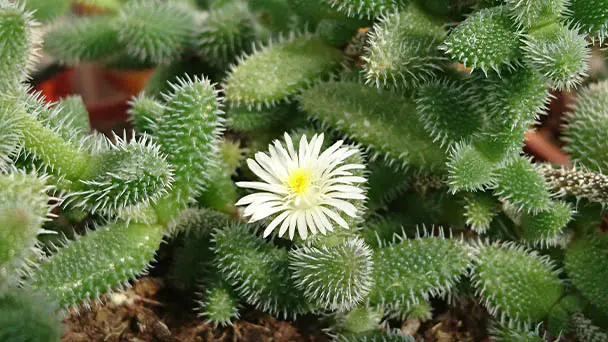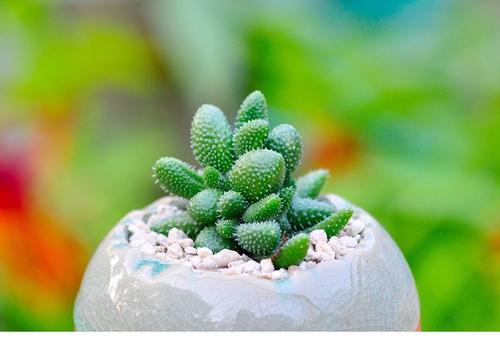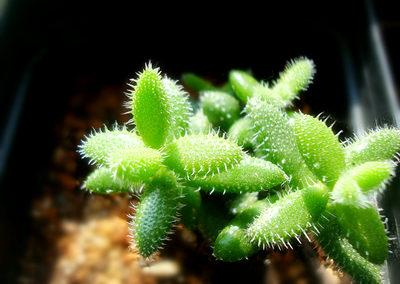How to grow and care for Pickle plant (Delosperma Echinatum)
Written by Maggie
Nov 11 2021

Pickle plant (Delosperma Echinatum) is a succulent plant of the genus Eucalyptus, originating in the hills and lowlands of southern, eastern and central South Africa. So how do Pickle plants grow? Here's how to grow and care for Pickle plants.
Pickle Plant Quick Info
| Botanical/Scientific Name | Delosperma Echinatum |
| Common Name | Pickle Plant |
| Uses | Ornamental plant |
| Origin | South Africa |
| Light Care | Light shade |
| Soil Care | Well-draining |
| Temperature Care | Slightly warm environment to grow |
| Humidity Care | Moisture |
| Watering | Water the plant once every three weeks in the winter |
| Pruning Care | Annual pruning in early spring |
| Fertilizer Care | Fertilizing the plants once a month or every 40 days |
| Propagation | Seeds/Cuttings/Divisions |
| Toxic | Not toxic |
| Flower Color | Yellow |
Pickle Plant Care in Detail
Pickle plant Environment care
Pickle plants need full sunlight and a cool, dry environment, tolerant of semi-shade, and avoid flooding and hot and humid conditions. It has the habit of growing in the cold season and dormant in high temperature in summer. pickle plants are not strict in their soil requirements. When we grow and care for Pickle plant, peat soil with coarse sand to keep water permeable is fine. Every year from autumn to summer of the second year for the growing season of the plant (flower friend environment is not the same, the growing season also has length), if the lack of light plants easy to grow, the upper and lower distance between the leaves and leaves will pull longer, make the plant more loose, the stem becomes very fragile very tender, the leaves will elongate, the color will become pale green. Pickle plants, on the other hand, do not grow too slowly when they grow in full sunlight and are relatively short and stout, and their leaves tend to be more tightly arranged.

Pickle plant Soil care
When we grow and care for Pickle plant, pickle plants need to keep the soil slightly moist during the growing season to avoid water accumulation. The soil is made of coal cinder mixed with peat and a small amount of perlite, with a ratio of about 6:3:1. The surface of the soil is paved with river sand. Pickle plants can withstand temperatures as low as -4 ° C when the soil is dry, indoors, not outdoors. The whole winter basic water, 5 degrees below will begin to slowly cut off water. When the summer temperature exceeded 35℃, the whole plant growth basically stopped. When we grow and care for Pickle plant, we should reduce watering to prevent root rot caused by excessive moisture of basin soil. And strengthen ventilated, appropriate shade, avoid the strong sunlight, the whole summer such basic maintenance, is worthy of that summer, water is not the entire season, is the only tiny amounts of water, or leaflets of easy to dry, water it only at the edge of the basin about 2-4 times a month, 7-9 o 'clock in the evening feed water, when the sun is setting, will not affect the roots of plants.
Read more:
Pickle Plant Succulent Propagation & Care Guide
Pickle plant Repot care
Pickle plants should be cultivated without prolonged rain to prevent root damage and shoots from turning yellow and rotting. When we grow and care for Pickle plant, because pickled plants grow relatively quickly, they are ready to be repotted once or twice a year, before the first watering in early spring. Pickle plants are not very large, but are branched and can be propagated by cutting and splitting.

Pickle Plant Watering
In the process of daily maintenance, pickle plant watering also needs attention. It is often found that pickle plant has rotten roots when propagation. The reason is that it is watered too much. Pickle plant is a plant that doesn't like too much water. Generally, it can be watered twice or four times a month, and the principle of "don't dry, don't water, and water thoroughly" should be mastered.
When watering pickle plant, we also need to pay attention not to pour it directly on the plant, especially not directly near the root. When watering, we should pour it slowly along the edge of the basin. Don't leave ponding in the basin soil, otherwise the pickle plant will rot roots for you to see. In the summer with higher temperature and winter with lower temperature, pickle plant will enter the dormancy period. At this time, we should reduce the watering times and water it once a month.
Pickle Plant Light
Succulent plants like light, and pickle plant is no exception. Insufficient light will make the pickle plant grow in vain, the leaves will become sparse and dull, and the branches will become slender. As we all know, fleshy plant types are short and strong, more beautiful. The leaves of pickle plant receiving sufficient light will be arranged closely, the branches will be thick, and the ornamental value will be much higher than that of bare plant. However, in the high temperature season in summer, pay attention to shading to avoid sunburn of pickle plant during dormancy.
The growth period of pickle plant is from September to June of the next year. If the light is insufficient, the plant is easy to grow in vain, and the up-down distance between leaves will be longer, making the plant type more loose, the stem becomes very fragile and green, the leaves will also be elongated, and the color will become light green. The plants growing in sunny places are relatively short and strong, and the arrangement of leaves will be relatively compact.
Pickle Plant Temperature
The temperature suitable for the growth of pickle plant is between 15 ℃ and 25 ℃, and the overwintering temperature in winter shall not be lower than 5 ℃, otherwise it will cause damage to pickle plant. When the temperature in summer is higher than 30 ℃, the pickle plant will enter the dormancy period. At this time, pay attention to shading to prevent the pickle plant from sunburn.
Pickle Plant Humidity
Pickle plant needs a sunny, cool and dry environment, resistant to semi shade, afraid of water logging, and avoid a humid environment. Pickle plant has the habit of growing in cold season and dormant in high temperature in summer.
Pickle Plant Fertilizer
Pickle plant was originally born in the arid subtropical region of South Africa. It is more barren resistant, but appropriate fertilization can effectively promote its growth and make it grow more robust. We can use liquid fertilizer to fertilize pickle plant. As long as it is fully diluted and decomposed, it can be organic or inorganic. When applying fertilizer to pickle plant, we should pay attention to avoid polluting the leaves, and do not apply it when it is sick.
Pickle Plant Pruning
Due to the strong germination ability of pickle plant, the plant grows very rapidly and it is easy to make the branches and leaves grow luxuriantly and densely. However, this is not good-looking and will consume too much nutrients. Therefore, pickle plant pruning should be carried out in time. If the pickle plant grows too much and the branches and leaves are too fine, it also needs to be re sheared. This can not only improve the plant type, but also promote the growth.
However, if the pickle plant is not beautiful and lacks modeling effect, in addition to re cutting, we can also update it by changing pots. Moreover, proper pruning is also needed to improve the plant type, so that the pickle plant potted plants are often more attractive and ornamental. Heavy cutting is mainly to meet the needs of pruning modeling, and sparse cutting is to improve the ventilation and light transmittance of potted plants, so as to receive more light and make plants grow more vigorously.
Pickle Plant Pest & Disease Control
Scale insects are common diseases and insect pests in pickle plant. They like to live on leaves and eat leaves and absorb plant juice. Plants targeted by scale insects tend to be depressed, especially succulent plants. Nutrients are all stored on fleshy leaves, which are easy to wither as soon as they are absorbed by scale insects.
If this pickle plant disease is discovered earlier, we can clean the scale insects by brushing with a toothbrush. When the scale insects have formed a scale and begin to flood, they can be wiped with alcohol and placed in a ventilated place.
Aphid is also a social insect. It is small enough to fly with the wind. Once it meets a suitable place, it will camp, which is difficult to prevent. Moreover, aphids reproduce very fast. If they don't pay attention, they may cover all corners of the fleshy, and then eat up the fleshy.
To deal with this pickle plant disease, we should find and treat it early. After aphids were found, they were quickly isolated. To deal with aphids, you can choose to spray pepper water, cut the pepper into sections and soak it in water, and then spray the plants.
Powdery mildew mainly occurs in the hardened middle and lower parts of branches or the back of old leaves, which is mainly caused by bacterial infection. Infected with this pickle plant disease will cause irreversible damage to plants. Even if it is cured, the original white traces will not disappear, which is terrible. Therefore, prevention is the key to deal with powdery mildew.
Pickle Plant Cutting Propagation
Pickle plant likes sunlight and is drought resistant. Because it grows relatively fast, it needs to change the basin once a year or two. The basin should be changed before the first watering in early spring. This is the best time for pickle plant cutting propagation. The plant shape of pickle plant is not too large, but it has branches, so it can be cut off, cut and split. Pickle plant branch cutting is very simple. We can take down the healthy old branches and dry them in the slightly wet sand. If it is cool and ventilated for more than 20 days, it will basically grow roots. Do not often supply water for cutting, otherwise it is easy to rot stems. Pick plant cutting propagation should choose spring and autumn. Picket plant propagation by cuttings can be carried out in the growing season. The requirements for the length of cuttings are not strict. The cuttings cut off can be dried for 1 ~ 2 days. After cutting, it is easy to take root because the soil is slightly moist.
Pickle Plant Benefits
Pickle plant has numerous branches and dense leaves, green and lovely. The small and exquisite fleshy leaves are covered with fleshy thorns, which are like green thorns. It is strange and lovely. Although the small yellow and white flowers are not big, they are dotted among the green branches and leaves, giving people a sense of simplicity and elegance.
Pickle plant has beautiful leaf shape and color, which has certain ornamental value; Potted plants can be placed next to televisions and computers to absorb radiation. They can also be planted indoors to absorb formaldehyde and other substances and purify the air.
Latest Updated
- Benefits of Bugleweed - 7 Science-backed Health Benefits
- Bugleweed Dangers & Side Effects - Is It Poisonous?
- How to Plant Evergreen Trees - What You Should Know
- When to Plant Evergreens - Grow Guide for Evergreen Trees
- 12 Wonderful Evergreen Shrubs for Your Garden
- 12 Popular Evergreen Plants with Pictures for Beginners
- When And How To Prune A Lilac Bush Like a Pro
- How to Grow & Care for Lilac Vine (Hardenbergia Violacea)
- Japanese Lilac Tree (Syringa Reticulata) Care & Propagation Guide
- Shumard Oak Pros and Cons - What to Know
Popular Articles
- Winter maintenance of Antirrhinum Majus
- How to Grow Terminalia Mantaly Tree
- How to Grow and Care for Crossostephium Chinense
- How to grow Antirrhinum Majus in spring
- Peristeria Elata (Dove Orchid) Profile: Info & Care Guide
- Underwatered Snake Plant (Sansevieria Trifasciata) - Signs And How To Fix
- How to Care for Brazilian Jasmine Plant (Mandevilla Sanderi)
- How to Grow & Care for Graptopetalum Purple Delight in Summer
- Rosa Chinensis (China Rose): Plant Growing & Care Tips
- How to Care for Baby Sun Rose (Aptenia Cordifolia)